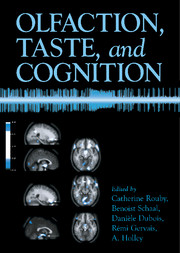Book contents
- Frontmatter
- Contents
- Contributors
- Preface
- Acknowledgments
- A Tribute to Edmond Roudnitska
- OLFACTION, TASTE, AND COGNITION
- Section 1 A Specific Type of Cognition
- Section 2 Knowledge and Languages
- Section 3 Emotion
- Section 4 Memory
- Section 5 Neural Bases
- 18 Odor Coding at the Periphery of the Olfactory System
- 19 Human Brain Activity during the First Second after Odor Presentation
- 20 Processing of Olfactory Affective Information: Contribution of Functional Imaging Studies
- 21 Experience-induced Changes Reveal Functional Dissociation within Olfactory Pathways
- 22 Increased Taste Sensitivity by Familiarization to Novel Stimuli: Psychophysics, fMRI, and Electrophysiological Techniques Suggest Modulations at Peripheral and Central Levels
- 23 The Cortical Representation of Taste and Smell
- Section 6 Individual Variations
- Index
- References
23 - The Cortical Representation of Taste and Smell
Published online by Cambridge University Press: 21 September 2009
- Frontmatter
- Contents
- Contributors
- Preface
- Acknowledgments
- A Tribute to Edmond Roudnitska
- OLFACTION, TASTE, AND COGNITION
- Section 1 A Specific Type of Cognition
- Section 2 Knowledge and Languages
- Section 3 Emotion
- Section 4 Memory
- Section 5 Neural Bases
- 18 Odor Coding at the Periphery of the Olfactory System
- 19 Human Brain Activity during the First Second after Odor Presentation
- 20 Processing of Olfactory Affective Information: Contribution of Functional Imaging Studies
- 21 Experience-induced Changes Reveal Functional Dissociation within Olfactory Pathways
- 22 Increased Taste Sensitivity by Familiarization to Novel Stimuli: Psychophysics, fMRI, and Electrophysiological Techniques Suggest Modulations at Peripheral and Central Levels
- 23 The Cortical Representation of Taste and Smell
- Section 6 Individual Variations
- Index
- References
Summary
The aims of this chapter are to describe the rules that appear to govern the cortical processing of taste and smell, how taste and smell inputs combine with each other to form flavor, how visual and oral somatosensory inputs also converge with taste and smell, and how hunger affects the representations in different cortical areas. Particular attention is paid to investigations in a non-human primate, the macaque, because they have provided fundamental evidence relevant to understanding information processing in the same areas in humans, and to neuroimaging studies in humans to complement the primate studies. A broad perspective on the brain processing involved in emotion and motivation is provided elsewhere (Rolls, 1999a).
Taste Pathways in Primates
A diagram of the taste and related pathways in primates is shown in Figure 23.1. Of particular interest is that in primates there is a direct projection from the rostral part of the nucleus of the solitary tract (NTS) to the taste thalamus and thus to the primary taste cortex in the frontal operculum and adjoining insula (Figure 23.2), with no pontine taste area and associated subcortical projections as in rodents (Norgren, 1984; Pritchard et al., 1986). The emphasis on cortical processing of taste in primates appears to be related to the extensive development of the cerebral cortex in primates and to the advantage of using similar cortical analyses of inputs from every sensory modality before the analyzed representations from all modalities are brought together in multimodal regions, as will be documented here.
- Type
- Chapter
- Information
- Olfaction, Taste, and Cognition , pp. 367 - 388Publisher: Cambridge University PressPrint publication year: 2002
References
- 7
- Cited by

